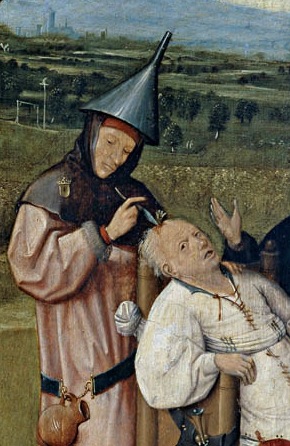Stone of madness
Stone of Madness refers to a historical belief in a physical cause for mental illness, specifically the theory that a stone formed inside the brain was responsible for symptoms of madness. This concept, prevalent in the Middle Ages, led to the practice of trepanation—the surgical act of drilling or scraping a hole into the human skull to remove the so-called stone of madness. The belief in the stone of madness is a fascinating example of the early attempts to understand and treat mental illness through physical means.
History[edit | edit source]
The idea of the stone of madness can be traced back to ancient times, but it became particularly prominent in Europe during the Middle Ages. It was widely believed that the symptoms of what we would now recognize as various forms of mental illness, such as melancholia, mania, and lunacy, were caused by literal stones that formed within the brain. These stones were thought to interfere with the individual's reason and emotions.
Hieronymus Bosch, a Dutch painter from the 15th century, famously depicted the extraction of the stone of madness in his painting "The Extraction of the Stone of Madness" (also known as "The Cure of Folly"). In this artwork, a surgeon, often interpreted as a charlatan, is shown removing the stone from a patient's head, symbolizing the futile and misguided treatments for mental illness of the time.
Medical Practices[edit | edit source]
The treatment for the stone of madness, trepanation, is one of the oldest surgical procedures known to humanity, with evidence of its practice dating back to prehistoric times. During the Middle Ages, it was revived as a treatment for mental illness, among other ailments. The procedure involved removing a piece of the skull to access the brain and supposedly remove the stone causing the patient's distress. This practice reflects the rudimentary understanding of mental illness in the past and the lengths to which people would go to find relief from its debilitating effects.
Cultural Impact[edit | edit source]
The belief in the stone of madness and the practice of trepanation have had a lasting impact on cultural perceptions of mental illness and its treatment. The image of the stone of madness represents the historical stigmatization and mystification of mental health conditions. It also highlights the evolution of medical theories and practices, from supernatural explanations to the development of modern psychiatry and neurology.
Modern Interpretations[edit | edit source]
Today, the stone of madness is understood as a metaphor for the elusive nature of mental illness and the challenges of treating conditions that have complex psychological, biological, and social dimensions. The story of the stone of madness serves as a reminder of the importance of scientific rigor and compassion in the approach to mental health.
See Also[edit | edit source]
Search WikiMD
Ad.Tired of being Overweight? Try W8MD's physician weight loss program.
Semaglutide (Ozempic / Wegovy and Tirzepatide (Mounjaro / Zepbound) available.
Advertise on WikiMD
|
WikiMD's Wellness Encyclopedia |
| Let Food Be Thy Medicine Medicine Thy Food - Hippocrates |
Translate this page: - East Asian
中文,
日本,
한국어,
South Asian
हिन्दी,
தமிழ்,
తెలుగు,
Urdu,
ಕನ್ನಡ,
Southeast Asian
Indonesian,
Vietnamese,
Thai,
မြန်မာဘာသာ,
বাংলা
European
español,
Deutsch,
français,
Greek,
português do Brasil,
polski,
română,
русский,
Nederlands,
norsk,
svenska,
suomi,
Italian
Middle Eastern & African
عربى,
Turkish,
Persian,
Hebrew,
Afrikaans,
isiZulu,
Kiswahili,
Other
Bulgarian,
Hungarian,
Czech,
Swedish,
മലയാളം,
मराठी,
ਪੰਜਾਬੀ,
ગુજરાતી,
Portuguese,
Ukrainian
Medical Disclaimer: WikiMD is not a substitute for professional medical advice. The information on WikiMD is provided as an information resource only, may be incorrect, outdated or misleading, and is not to be used or relied on for any diagnostic or treatment purposes. Please consult your health care provider before making any healthcare decisions or for guidance about a specific medical condition. WikiMD expressly disclaims responsibility, and shall have no liability, for any damages, loss, injury, or liability whatsoever suffered as a result of your reliance on the information contained in this site. By visiting this site you agree to the foregoing terms and conditions, which may from time to time be changed or supplemented by WikiMD. If you do not agree to the foregoing terms and conditions, you should not enter or use this site. See full disclaimer.
Credits:Most images are courtesy of Wikimedia commons, and templates Wikipedia, licensed under CC BY SA or similar.
Contributors: Prab R. Tumpati, MD

